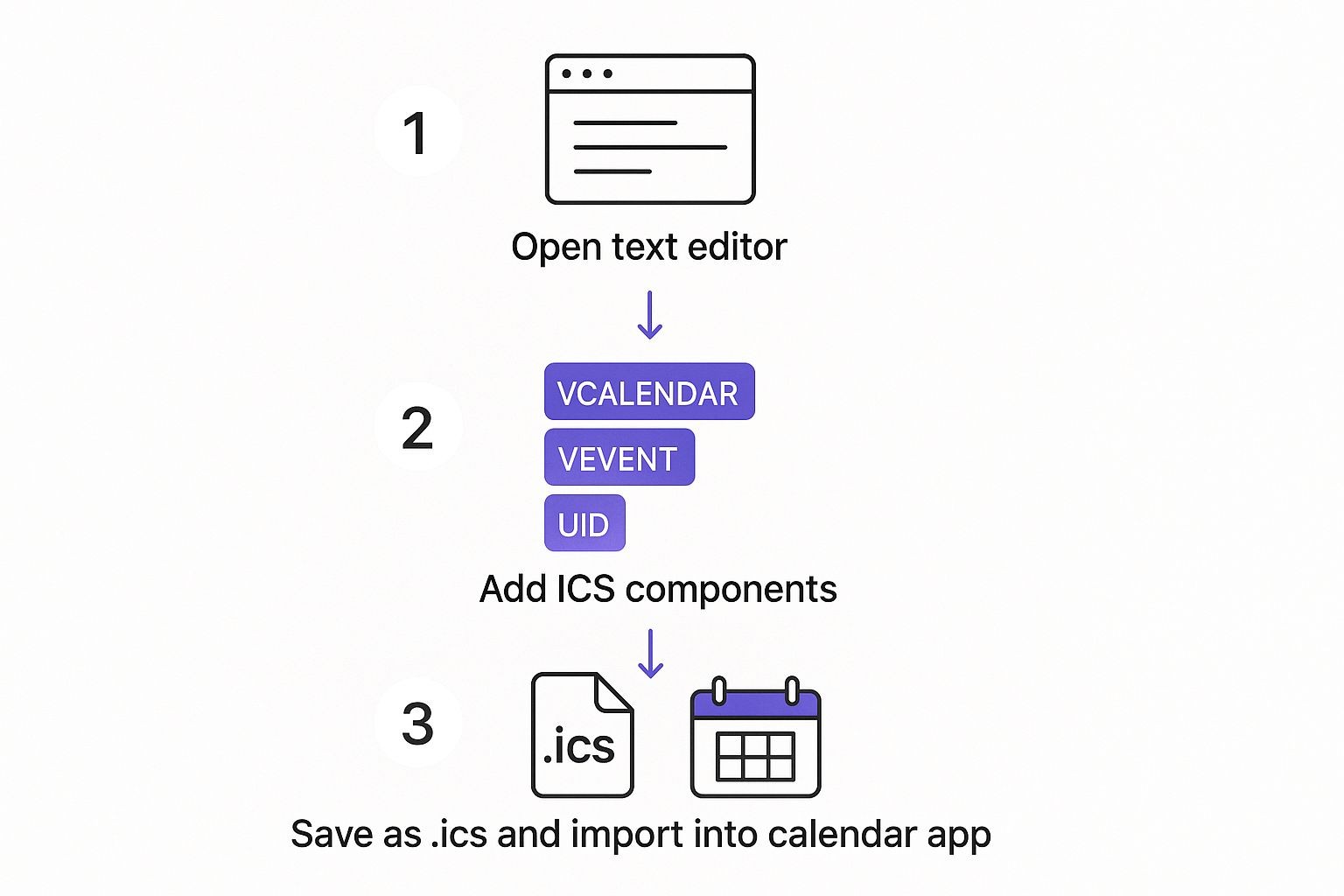Whether you need to send a meeting invitation or share a webinar schedule, you have two main paths to create an ICS file. You can either build a plain text file from scratch using iCalendar's specific format, or you can use a dedicated tool to handle the technical details for you. Either way, the goal is to create a universal file that works seamlessly with Google Calendar, Apple Calendar, and Outlook, ensuring your event details are shared perfectly.
Getting to Grips With the ICS File Format
Before we jump into the "how," it’s helpful to understand the "what." At its core, an .ics file is just a simple plain text file that follows a very specific set of rules. Think of it as a universal language that all the major calendar apps understand. This is what ensures your event details translate flawlessly from your system to your user's calendar, no matter what they use.
This isn't a modern invention. The iCalendar format was officially standardized way back in 1998 by the Internet Engineering Task Force (IETF) as RFC 2445. The whole point was to create a reliable, interoperable way to share calendar data. It’s been tweaked over the years to keep up with modern needs, like adding better support for conference calls, but its core reliability is what matters.
Why This Format Is Still the Gold Standard
The real magic of the iCalendar standard is its interoperability. When you send someone an ICS file, you're not just sending a block of text; you're handing their calendar app a neatly packaged, structured piece of data it can instantly understand and process.
This structure is what allows for a rich set of information that goes way beyond a simple date and time. An ICS file can pack in a lot of detail:
- A full event description, complete with formatting.
- A specific location that can even link out to a map.
- Alarms and reminders that pop up before the event starts.
- Status updates, like "CONFIRMED" or "CANCELLED."
- Rules for recurring events, perfect for things like weekly team syncs.
As the Social Media Manager for Add to Calendar PRO, I’ve seen just how crucial this is. A well-crafted ICS file makes for a seamless user experience, letting someone add your webinar or sales demo to their schedule with a single click. It's a simple action that can make a huge difference in attendance rates.
The key takeaway: The ICS format's strength is its power to bundle all the critical event info into one, universally understood file. This removes all the friction for your user and makes sure your event details are saved accurately.
This reliability is exactly why we built our service around it. Doing this all by hand can be a real headache and it’s easy to make mistakes, especially when you're juggling tricky details like timezones or complex recurring events. Using a tool designed to handle these nuances ensures you get a perfect result every single time. The rest of this guide will walk you through both the manual and automated ways to create these powerful little files.
Creating Your First ICS File Manually

Diving into your first manual ICS file might feel a bit technical, but it’s surprisingly straightforward. You don't need any special software to get started. A simple text editor like Notepad on Windows or TextEdit on a Mac is all you need.
At its heart, an ICS file is just a plain text file that follows a specific set of rules - the iCalendar syntax. The whole thing starts with BEGIN:VCALENDAR and wraps up with END:VCALENDAR. Inside that, each event you create gets its own BEGIN:VEVENT and END:VEVENT block.
This text-based approach is what makes it so powerful. You can easily create, share, and import these files across all the major calendar platforms, from Google Calendar to Microsoft Outlook. You can dig deeper into the technical specifications of the iCalendar format to see how all the pieces fit together.
Laying the Groundwork with VCALENDAR
Before you can add an event, you have to set up the calendar that will hold it. This is where the VCALENDAR block comes in. Think of it as the envelope for your event letter. Every single ICS file has to start and end with these tags.
Here are the essential bits you'll always need:
BEGIN:VCALENDAR VERSION:2.0 PRODID:-//Your Company//Your Product//EN END:VCALENDAR
Let's break that down real quick:
BEGIN:VCALENDARandEND:VCALENDARare the non-negotiable bookends.VERSION:2.0just tells calendar apps you're using the current iCalendar standard. It's best to stick with 2.0.PRODIDis a product identifier. It's a handy way to trace where the file originated. You can and should customize this to represent your own company or app.
Building Your VEVENT Block
With the calendar "envelope" ready, it's time for the good stuff: the actual event details. This all happens inside a VEVENT block, which is nested inside your VCALENDAR tags. This is where you put all the critical info your attendees need.
Let's say we're creating an event for a "Quarterly Team Kickoff." We'll need to define a few key properties to make this work.
Pro Tip: One of the most overlooked but crucial properties is the
UID(Unique Identifier). This string of text gives your event a unique identity. If you ever need to send an update, calendar apps use thisUIDto find and modify the existing event instead of creating a confusing duplicate.
Here are the must-have properties for our team meeting:
- DTSTAMP: The timestamp for when you created the event itself.
- UID: The unique ID for the event. A common and solid practice is to combine a timestamp with your domain name.
- DTSTART: The event's start date and time.
- DTEND: The event's end date and time.
- SUMMARY: This is the event title people will see on their calendar.
- DESCRIPTION: A more detailed explanation of what the event is about.
- LOCATION: The physical or virtual location of the meeting.
Putting it all together, here’s a complete, commented snippet for our team kickoff. You can copy this code, paste it into a plain text file, and save it with an .ics extension to create a working calendar event.
BEGIN:VCALENDAR VERSION:2.0 PRODID:-//Your Kickoff Meeting//EN BEGIN:VEVENT UID:[email protected] DTSTAMP:20240801T120000Z DTSTART:20240915T140000Z DTEND:20240915T150000Z SUMMARY:Quarterly Team Kickoff DESCRIPTION:Join us for the Q4 kickoff to review last quarter's results and align on new goals. LOCATION:Conference Room 4B END:VEVENT END:VCALENDAR
By building this file from scratch, you get a much clearer picture of how the format actually works. This hands-on experience demystifies the whole process and proves that creating a basic ICS file is something anyone can do, not just developers.
Alright, you've got the basics of building a single event down. Now, let's get into the good stuff - the more powerful features that turn a simple ICS file into a seriously useful tool for real-world scheduling.
When you move beyond one-off appointments, you open up a whole new level of engagement. Think about managing a global webinar series or even just a recurring weekly team meeting. This is where you learn to make an ICS file that truly works for you, not against you.
The magic is in understanding the properties that handle complexity, like recurring events and timezones. These are the details that separate a basic reminder from a professional, reliable event invitation that people can trust.
This handy infographic breaks down the fundamental workflow for creating an ICS file by hand.

As you can see, the process really just comes down to three actions: writing out the event details, structuring that text with the right components, and saving it with the .ics extension so calendar apps know what to do with it.
Setting Up Recurring Events with RRULE
Nobody wants to manually create a calendar entry for every single session of a weekly sync-up or a monthly webinar. It’s tedious and a recipe for mistakes. This is exactly why the RRULE (Recurrence Rule) property is a game-changer. It lets you define a complex repeating pattern for an event with just a single entry.
The RRULE property uses a few key parameters to build the schedule:
FREQ: This is the core frequency of the event. Your main options areDAILY,WEEKLY,MONTHLY, orYEARLY.INTERVAL: This defines how often that frequency happens. For instance,FREQ=WEEKLY;INTERVAL=2means the event occurs every two weeks.UNTIL: This sets a specific end date for the recurrence, so the event series doesn't run on forever.
For a weekly team meeting that happens every Monday at 9 AM, your RRULE might look like this: RRULE:FREQ=WEEKLY;BYDAY=MO. One simple line of text saves you from creating dozens of individual events. It’s that easy.
Adding Alarms and Richer Details
A calendar event is much more than just a block of time; it's a communication tool. You can - and should - embed critical information directly into the ICS file to make sure your attendees show up prepared and on time.
The VALARM component is how you set reminders. You can configure an alarm to pop up a specific amount of time before the event kicks off. A line like TRIGGER:-PT15M sets a notification to appear 15 minutes before the start time.
You can also make your DESCRIPTION property much easier to read. The trick is to use the \n character to add line breaks. This lets you format bulleted lists, include hyperlinks, or just separate paragraphs within the event description. The result is a much cleaner and more professional look in the user's calendar.
For anyone managing events for a global audience, correctly handling timezones isn't just a feature - it's a requirement. A single mistake can cause attendees to miss an event entirely. This is one of the most common and frustrating pitfalls when creating an ICS file from scratch.
The Critical Role of Timezones
When you have people joining from different corners of the world, defining the timezone is absolutely non-negotiable.
The most robust way to handle this is with the VTIMEZONE component. It allows you to embed the full timezone definition, including all the tricky daylight saving rules, directly within the ICS file itself.
You then reference this timezone in your start and end times using the TZID parameter. It looks something like this: DTSTART;TZID=America/New_York:20241120T100000. This is what ensures the event time adjusts perfectly for every single user, no matter where they are.
While it's the most accurate method, it's also the most complex to get right by hand. This is one area where automation, like the kind our service provides, can save you from some significant and embarrassing scheduling headaches.
Automating ICS File Generation for Developers

When you’re managing events at scale, creating ICS files by hand isn't an option. Can you imagine generating hundreds of unique calendar files for a webinar series one by one? It would be a logistical nightmare. This is where programmatic generation comes in, turning a mind-numbing task into a slick, automated workflow.
Instead of trying to write raw ICS text (and worrying about syntax), you can lean on specialized libraries that handle all the tricky formatting for you. It’s not just about saving time; it’s about drastically cutting down on the kinds of syntax errors that can make your calendar file completely unreadable.
Choosing the Right Library for Your Stack
Thankfully, most modern programming languages have solid, open-source libraries ready to create ICS files on the fly. These tools give you simple functions or methods to define your event properties, and they do the heavy lifting of compiling everything into a perfectly formatted, RFC-compliant file.
Here are a couple of popular choices that are used effectively:
- JavaScript (Node.js & Browser): The
ics.jslibrary is a fantastic pick for both front-end and back-end work. You can build an event object and have it generate the ICS content, which you can then serve up as a download. It's super straightforward. - PHP: Libraries like
spatie/icalendar-generatorare widely used and well-maintained. They provide a clean, object-oriented way to build calendar events, manage timezones, and even set up recurrence rules.
If you're looking to plug ICS file generation into a bigger system, you might also want to look at general workflow automation tools like n8n. These platforms can connect different apps and services, letting you create ICS files as one step in a much larger process.
A Practical Code Example
Let's walk through a classic scenario. A user signs up for an event on your website, and you want to offer them an "add to calendar" download immediately. The backend code would grab the form data, use a library to build the event, and then trigger a file download in the user's browser.
Here’s what that might look like in a simplified JavaScript example using the ics library:
import { createEvent } from 'ics';
// Imagine you pulled these values from a form submission or your database const eventDetails = { title: 'Product Demo Webinar', description: 'Live demo of our new features.', start: 2024, 10, 26, 10, 0, // Year, Month, Day, Hour, Minute duration: { hours: 1 }, };
createEvent(eventDetails, (error, value) => { if (error) { console.log(error); return; }
// 'value' is now a string containing the full ICS file content
// From here, you can create a blob and trigger a download
console.log(value);
});
See how the library abstracts away all the messy details? You don't have to worry about DTSTART formatting or the VCALENDAR structure; you just focus on the event data.
One critical piece of advice for automation: make sure every single event gets a truly unique
UIDand an accurateDTSTAMP. If you use a staticUID, calendar clients will just overwrite existing events, which is a recipe for confusion. Always generate a newUID- based on a timestamp or a random string - for each unique event. If you want to dive deeper into how different calendars, especially Google, handle these files, check out our guide on Google Calendar and ICS files.
Automating this process is the key to embedding a smooth "add to calendar" feature right into your applications. It’s a small touch that provides a genuinely professional experience for your users.
A Simpler Way: Using Add to Calendar PRO for Your Events
Going the manual or programmatic route gives you a ton of control, but it's a rocky path. The learning curve is steep, and the potential for a tiny typo to break everything is frustratingly high. One misplaced character in an ICS file, and the whole thing is useless.
As the Social Media Manager at Add to Calendar PRO, I’ve seen these headaches firsthand. In fact, our service was built specifically to solve these exact problems.
Instead of wrestling with code or carefully crafting text files, you can generate solid, professional 'add to calendar' links and buttons in just a few clicks. Our platform handles all the messy technical stuff in the background, letting you get back to what you do best - planning your actual event.
Automated, Error-Free, and Ready to Go
The biggest pain points in manual ICS creation are always the most critical details. Think about trying to manage timezones for a global webinar or setting up a complicated recurring event. It's a minefield.
Our service just handles these tricky parts for you automatically:
- Timezone & Daylight Saving: We make sure every attendee sees the right time, no matter where they are. The platform properly handles
VTIMEZONEand all those pesky daylight saving adjustments so you don't have to. - Recurring Events (RRULEs): You can set up daily, weekly, or custom repeating events through a simple form - no need to even know what an
RRULEstring is. - Cross-Platform Compatibility: The links and files we generate are constantly tested and optimized to work perfectly across Google Calendar, Outlook, Apple Calendar, and more.
While building your own ICS files offers total control, specialized solutions like the best marketing calendar software options can seriously streamline how you plan and distribute events. Our tool slots right into that ecosystem as a specialized solution for event sharing.
By automating ICS file generation, you're not just saving time; you're actively preventing all the common pitfalls we've talked about. This turns a complex technical chore into a simple, reliable part of your marketing workflow, helping boost attendance and giving your audience a polished, professional experience.
A Strategic Asset for Your Events
At the end of the day, using a dedicated tool like ours is about more than just convenience. It’s a strategic decision to make sure every touchpoint for your event is professional and works flawlessly.
You get reliable, user-friendly calendar functionality without the technical overhead. That means you save precious time and resources that would otherwise be burned troubleshooting broken calendar invites.
Common Questions About Creating ICS Files
Even with a solid guide in hand, you're bound to run into a few tricky spots when building iCalendar files from scratch. As the Social Media Manager for Add to Calendar PRO, I see the same questions pop up time and time again.
Think of this section as a quick-and-dirty troubleshooting guide for those common sticking points. If you've hit a wall, chances are the answer you need is right here.
How Do I Handle Timezones Correctly in an ICS File?
This is, without a doubt, the most frequent question I see. And for good reason - get timezones wrong, and you'll have people showing up hours early or late, or missing your event entirely. It's a disaster waiting to happen.
There are really two main ways to tackle this:
- For global events (like a webinar): The simplest, most bulletproof method is to use Coordinated Universal Time (UTC). You just add a "Z" right at the end of your timestamp. It looks like this:
DTSTART:20241225T140000Z. That "Z" tells every calendar app this is an absolute time, no guesswork needed. - For localized events (like an in-person meeting): If your event is happening at 9:00 AM in New York, regardless of where the recipient is, you need to be more specific. You have to include a full
VTIMEZONEblock that defines the timezone, then reference it using theTZIDparameter, like this:DTSTART;TZID=America/New_York:20241225T090000.
Getting reminders right is another piece of this puzzle. If you're interested, we have a detailed guide on how to set up email event reminders that play nicely with your calendar invites.
What Is a UID and Why Is It So Important?
The UID, or Unique Identifier, is a special string of text that acts like a serial number for your event. Calendar apps like Google Calendar and Outlook rely on this UID to keep track of a specific event on a user's schedule.
The UID is absolutely critical for sending out event updates. If you need to change the time, location, or any other detail, the updated ICS file must have the exact same UID as the original. This is how the calendar app knows to modify the existing event instead of creating a confusing duplicate.
A common best practice is to generate a UID using something unique like a timestamp combined with your company's domain name. This helps ensure it’s genuinely one-of-a-kind.
Can I Put Multiple Events in One ICS File?
Yes, you can, and it's a fantastic way to share things like a multi-day conference schedule or an entire project timeline in one shot.
All you have to do is nest multiple VEVENT blocks - each with its own BEGIN:VEVENT and END:VEVENT tags - inside a single parent VCALENDAR block. When someone opens that file, their calendar app will see all the individual events and offer to import them all at once. It's incredibly convenient for the end-user.
At Add to Calendar PRO, we built our service to handle all these technical headaches for you. Instead of sweating the details over UIDs, timezones, and file formats, you can create professional, reliable add-to-calendar buttons and links that just work, every time. Take the guesswork out of sharing your events and visit https://add-to-calendar-pro.com to see how we do it.



